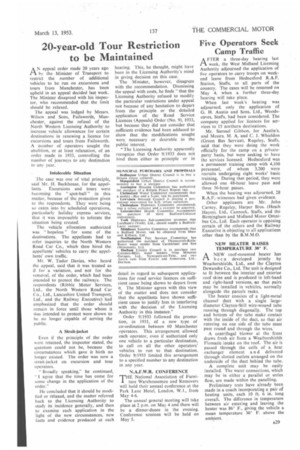Five Operators Seek Camp Traffic
Page 31

If you've noticed an error in this article please click here to report it so we can fix it.
AFTER a three-day hearing last week, the West Midland Licensing Authority adjourned the application of five operators to carry troops on weekend leave from Hednesford
Station, Staffs, to all parts of the country. The cases will be resumed on May 4, when a further three-day hearing will take place.
When last week's hearing was adjourned, only the application of G. H. Austin and Sons, Ltd., Woodseaves, Staffs, had been considered. The company applied for licences for services to 15 northern destinations.
Mr. Samuel Gibbon, for Austin's, and Messrs. M. A. and C. J. Whieldon (Green Bus Service), Rugeley, Staffs, said that they were doing the work officially for the camp on a Ovateparty basis, but were seeking to have the services licensed. Hednesford was a permanent training camp with 4,100 personnel, of whom 3,200 were recruits undergoing eight weeks' basic training. During that period, they were allowed one 48-hour, leave pass and three 36-hour passes.
When the hearing was adjourned, 28 R.A.F. witnesses had given evidence.
Other applicants are Mr. John Carney, Rugeley, Harper Bros. (Heath Hayes), Ltd., Cannock, Staffs, and the Birmingham and Midland Motor Omnibus Co,, Ltd. Each operator is opposing certain of the others and the Railway Executive is objecting to all applications other than by the B.M.M.O.
NEW HEATER RAISES TEMPERATURE 30° F.
ANEW roof-mounted heater has been developed jointly by Weathershields, Ltd., and the Clayton Dewandre Co., Ltd. The unit is designed to fit between the interior and exterior roof skins and is produced in left-hand and right-hand versions, to that pairs may be installed in vehicles, normally alongside the parcels racks.
The heater consists of a light-metal channel duct with a single largediameter Clayton-Still wire-wound tube running through diagonally. The top and bottom of the tube make contact with the inside of the duct, so that air entering on one side of the tube must pass round and through the wires.
A centrifugal blower at the front draws fresh air from a Weathershields Flomatic intake on the roof The air is passed through the coils of a heat exchanger element a n d delivered through slotted outlets arranged on the underside of the duct behind the tube.
A complete unit may be easily installed. The water connections, which may be in either a parallel or series flow, are made within the panelling.
Preliminary tests have already been made in a coach incorporating a pair of heating units, each 10 ft. 6 in. long overall. The difference in temperature between air entering and leaving the heater was 86° F., giving the vehicle a mean temperature 30° F. above the ambient.




















































































